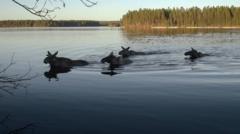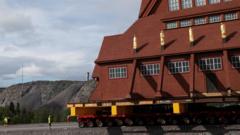Each spring, for the past six years, a captivating spectacle unfolds in northern Sweden as millions of viewers engage with "The Great Moose Migration” via a continuous livestream. This year’s event, which kicked off a week earlier than planned due to unusually warm early-April temperatures, showcases the moose's journey across the Angerman River to reach their summer grazing grounds.
The popular program, broadcasted on SVT Play - the streaming service of Sweden's national broadcaster - has garnered a passionate following since its start in 2019, becoming a hallmark of “slow TV.” Cait Borjesson, a dedicated viewer who discovered the stream during the pandemic, described it as remarkably soothing and an annual ritual that allows her to immerse in nature from home. "It’s like therapy," she remarked, highlighting the stream's impact on her anxiety and well-being, a sentiment echoed by many within an online community of over 77,000 members where viewers share their experiences and love for the migration.
The migration captures a unique ecological process as the moose, which historically have migrated since the last Ice Age, navigate through the picturesque landscapes of Kullberg, close to the Angerman. Goran Ericsson, a forestry dean and scientific advisor for the livestream, indicated that approximately 95% of the moose population in northern Sweden partake in this migration, citing that this year's early departure is not unprecedented.
Utilizing more than 30 cameras to document the migration, the broadcast amassed nearly one million viewers in its inaugural year, skyrocketing to nine million viewers by 2024. Researcher Minh-Xuan Truong emphasized the appeal of this slow-paced nature experience, as audiences often prefer the soothing sounds of the forest over added commentary or music.
Sweden is home to around 300,000 moose, which are affectionately referred to as the "King of the Forest," enriching the country’s woodland landscapes and drawing interest both locally and globally.



















